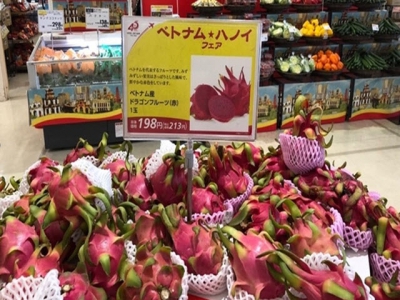Japan market share of dragon fruit needs to be maintained

Some 2,000 tons of Vietnamese dragon fruit are exported to Japan annually, for a market share of over 80 per cent. Continuous improvements to quality are now needed given the increasing competition in the market.
Dragon fruit is a familiar fruit to Japanese people. Japanese consumers consider dragon fruit to be a nutritious, fiber-rich fruit that brings beautiful and smooth skin. They often eat dragon fruit in a salad style, mixed with cereals, or eaten directly.
Mr. Ta Duc Minh, Commercial Counselor, Vietnam Trade Office in Japan, said that the demand for dragon fruit in Japan is quite high. Japan has grown dragon fruit in provinces such as Okinawa, Kagoshima, but the output is not much, and the fruit is small, sour and expensive. The price of a red flesh dragon fruit in Japan is about 400 - 500 yen / fruit (equivalent to 80,000 - 100,000 VND).
Every year Japan imports about 2,000 tons of Vietnamese dragon fruit. Vietnamese dragon fruit accounts for more than 80% of the market share of dragon fruit sold in Japan.
In 2009, Vietnam started exporting fresh white flesh dragon fruit, in January 2017 started exporting red flesh dragon fruit to Japan.
When the first time Vietnamese dragon fruit was brought into Japan, Yasaka Company (the first company to introduce hot steam heat treatment technology into Vietnam) chose to bring dragon fruit into the segment as a premium fruit. Only sold at department stores.
Dragon fruit is picked, processed and put on store shelves within 3 days to keep freshness and shipped by air.
In recent years, dragon fruits have been imported in larger quantities to Japan and by sea, so the price is also cheaper and sold in supermarkets all over Japan. Likewise, the competition of dragon fruit in the Japanese market has also increased.
Recently, many Vietnamese companies have started to introduce and offer processed dragon fruit products such as bottled dragon fruit juice, dried dragon fruit, etc., but the design and price are not suitable for consumers. use Japan.
"These products, if well-invested and well-researched to suit consumer tastes, will be able to have a good foothold in the Japanese market," said Mr. Minh.
To export fresh fruits in general and dragon fruit to Japan in a stable and sustainable manner is not easy. Because according to Mr. Minh, Japan is a very difficult market, when we let the quantity of fresh fruit exported to Japan for any reason is not good. Just one batch of fruit is not guaranteed to be fresh, does not ensure food hygiene and safety regulations, to have residue of plant protection substances, the efforts of farmers to grow delicious fruit will no longer be meaningful. .
“We need to implement a synchronous link from growing, processing, preserving, transporting and exporting to ensure fresh fruit, keep quality, keep brand name and keep market.” Mr. Minh noted.
"Some countries such as the US, Australia or Japan are famously fastidious markets, which have strict quarantine regulations and high standards for fresh fruit products imported from abroad. including dragon fruit".
Mr. Ta Duc Minh, Commercial Counselor, Vietnam Trade Office in Japan
Another issue noted by the Vietnam Trade Office in Japan is that Japanese consumers are always highly sensitive to the constant change in selling prices of certain products. Therefore, importers always want the stability of prices and supply from Vietnamese partners.
In addition, Vietnamese enterprises should also focus on investing in post-harvest technology and techniques to research and improve the quality and diversity of product types and forms to meet the distinct tastes of many customers. different customers.
In addition to the general regulations on growing conditions, handling, packaging, labeling, phytosanitary certificates, etc., fresh dragon fruits that want to be exported to this market must also ensure a number of technical regulations such as handling. Pest control, sampling for pre-treatment inspection, plant quarantine and certificates... However, compared to the US or Australia, the process of bringing fresh fruits into Japan takes longer with many difficulties.
For the US and Australia, dragon fruit exported to these two markets must be treated with irradiation at irradiation facilities that have been recognized by the Plant Protection Department (Ministry of Agriculture and Rural Development) under the supervision of the Department of Agriculture and Rural Development. supervision of plant quarantine officers of Vietnam.
Meanwhile, the requirements of Japan are somewhat stricter, that is, batches of dragon fruit for export must be treated with hot steam (minimum temperature of 47.5 degrees Celsius for 40 minutes, must ensure the temperature of the dragon fruit). brix). At the same time, the treatment of hot steam must be supervised by quarantine officers of both Vietnam and Japan.
Related news
 EU remains promising market for Vietnamese fruit
EU remains promising market for Vietnamese fruit European consumers have been increasingly interested in tropical fruits, especially healthy ones with novel taste
 More than 5,000 ha of mango in Dong Thap granted area codes for export
More than 5,000 ha of mango in Dong Thap granted area codes for export A total of 5,284 out of 12,000 hectares of mango in the Mekong Delta province of Dong Thap have secured area and packaging codes for export
 Strategy needed for vegetable exports to Europe
Strategy needed for vegetable exports to Europe Each year, this market imports about 35 billion euros, accounting for 45% of the global trade in fruit and vegetables. This is a potential market for Vietnamese